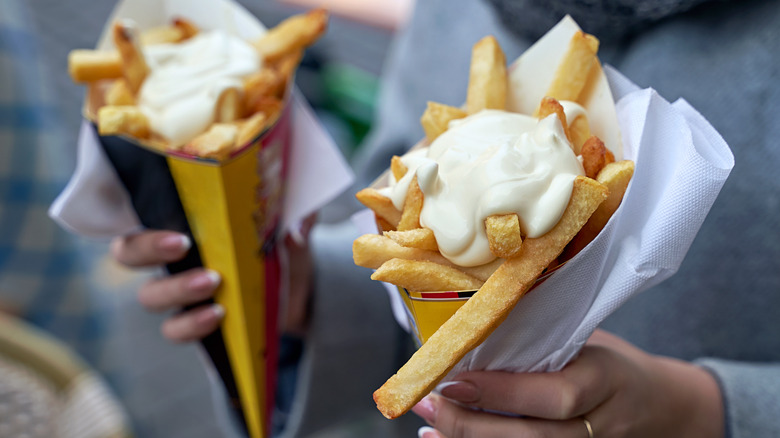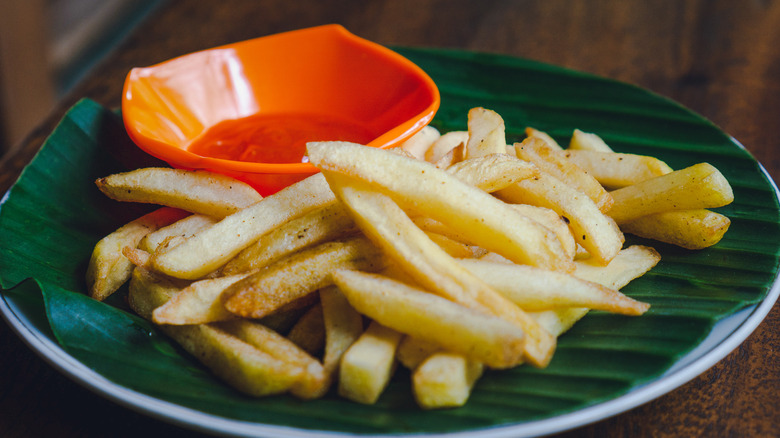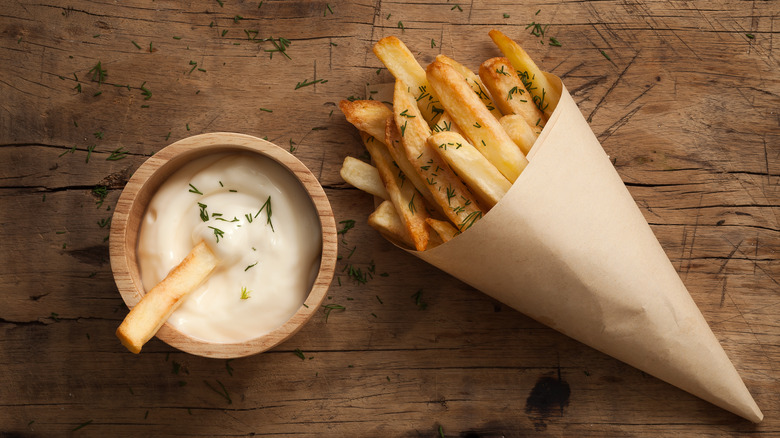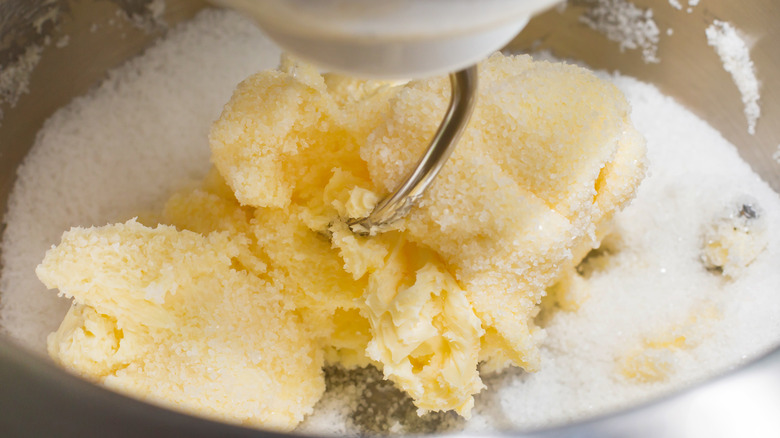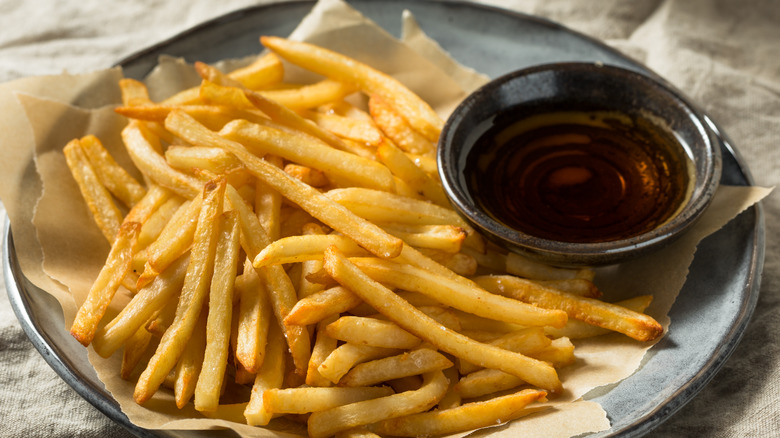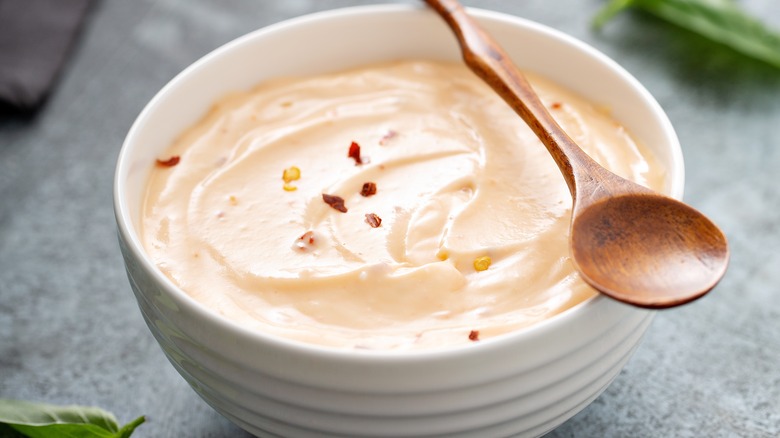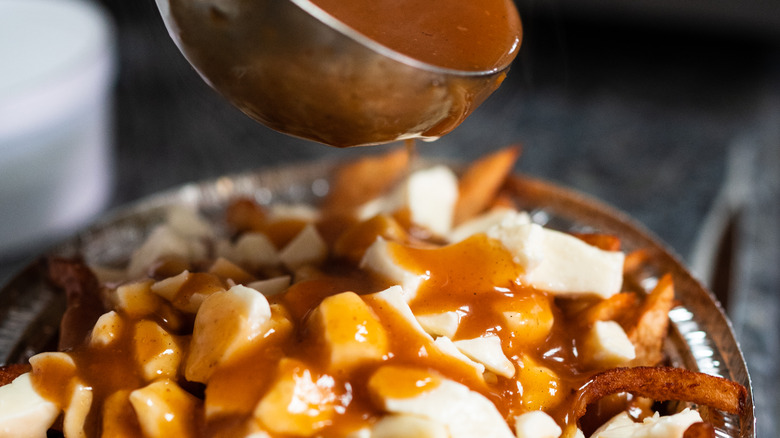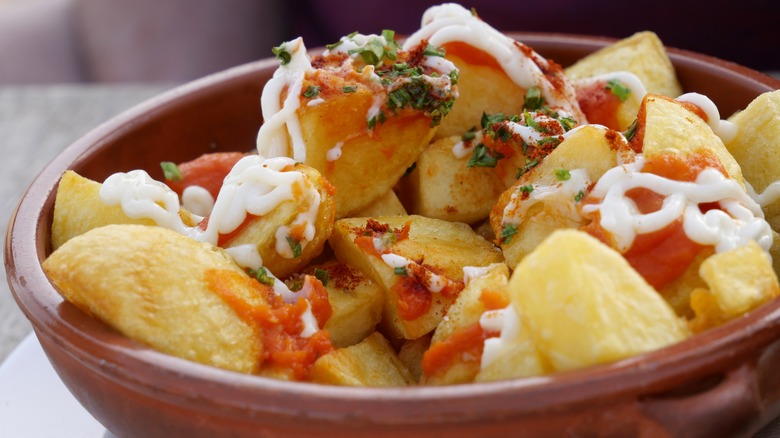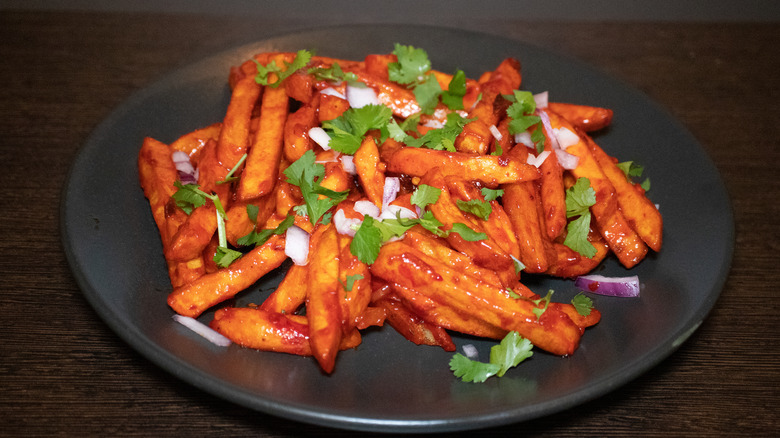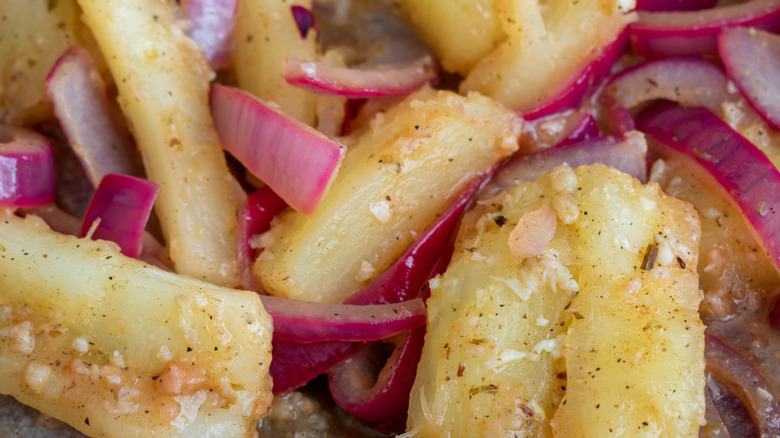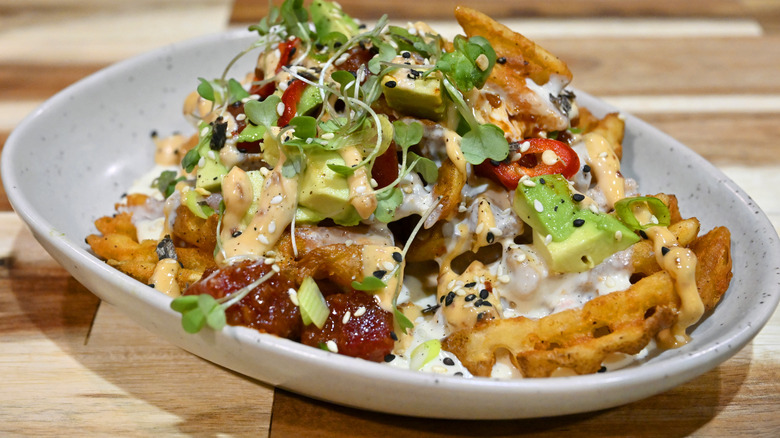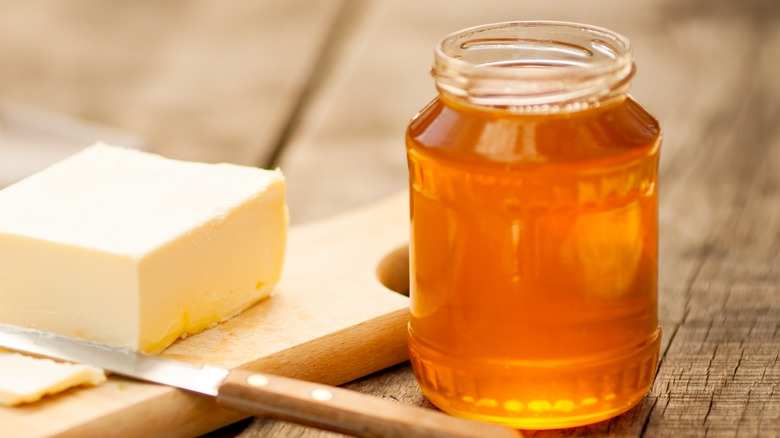What People Dip Their Fries In Around The World
If you love french fries and ketchup, it may be because the iconic red sauce is an aphrodisiac. Well, not scientifically speaking. However, back in 1812, when Philly-based horticulturist, James Mease, brought the world's first tomato ketchup to life, many people believed that tomatoes could make you fall in love. According to History, Mease was so big on this legend that he actually called tomatoes "love apples" in his notes. And, perhaps in the sense of a self-fulfilling prophecy, the scientist's invention got picked up in 1876 by a little company called Heinz. Soon, America fell in love with ketchup.
While the history of this amazing condiment is fascinating, it's worth noting that not everybody was equally enamored by the combination of french fries and ketchup. Sure, the combination of tart vinegar, sweet tomatoes, and rich brown sugar tastes fantastic on crunchy deep-fried potatoes. However, in other countries across the globe, french fry lovers dreamed up other ways of dressing these amazing snacks. From the Belgian culture of dunking their fries in creamy mayo to the Korean tradition of smearing them in butter and honey, culinary cultures across the world offer some unique and delicious ways to enjoy your french fries.
Belgium: Mayonnaise
Although there's a lot of talk about french fries being, well, French, food historians believe that this delicious food hails from Belgium. Legend has it that french fries were invented in the town of Namur in 1680. Apparently, the villagers there largely subsided on fried fish, but when their river froze over that cold, fateful winter, they resorted to frying potatoes instead. Regardless of whether or not this story is true, it remains clear that the Belgians have some of the deepest historic ties to french fries. Because of that, it should be noted that they don't eat their fries with ketchup.
Instead, Belgians enjoy their french fries with mayonnaise. Unlike ketchup, which can, at times, drown out the flavor of the potatoes, mayo can highlight their soft, earthy flavors. Interestingly, this is one of the main reasons why Belgians reach for mayonnaise over the tomato-filled American alternative — they prefer to enjoy the full effect of their fries' crunchy salty goodness over the acidic burn of tomato-infused potato sticks.
To enjoy your french fries the Belgian way, whip up a batch of homemade mayonnaise and serve it over a piping hot plate of potatoes. Here, the tangy yet creamy flavors of the mayo will contrast perfectly with your savory fries, accentuating their crispy texture and light inner flavor.
The Philippines: Banana ketchup
While the Belgian combination of fries and mayo is certainly delectable, it's far from being the only delightful pairing. In the Philippines, one of the most popular french fry dipping sauces is banana ketchup — a combination of vinegar, spices, sugar, and, of course, bananas. Generally speaking, this condiment is reminiscent of tomato ketchup, thanks to the strong vinegar element in both versions. However, banana ketchup tends to be a little thicker and sweeter than the tomato-based alternative, thanks to the fleshy nature of its fruity main ingredient. It also has a number of variations, with some chefs spicing the blend up through the addition of jalapeños.
Because banana ketchup combines the tanginess of vinegar with the sweet richness of bananas, it tastes wonderful on a plate full of fries. Here, the acidic vinegar component helps cut through the fattiness of the deep-fried potatoes, balancing out their overall flavor. Meanwhile, the natural sugar of the fruit will deepen the smooth creamy taste of the French fries' soft interior. In that sense, the banana adds a layer of complexity to the classic pairing of vinegar and fried carbohydrates, giving it a tropical feel.
Romania: Mudjei
If you are hoping to enjoy french fries with a strong, garlicky flavor, you might want to give mudjei a try. This classic, Romanian condiment is made by salting entire crushed cloves of garlic and then watering down the combination. To give the sauce a rich finish, cooks combine the final product with sunflower oil. Alternatively, to give it a more balanced, creamy texture, they add yogurt or sour cream. The result is a sauce that is powerful and acidic, with piquant overtones.
Traditionally, mudjei is served on heavier meat dishes, like sausages, pork, or even beef. However, these days, people enjoy mudjei with any number of international foods, including french fries. When served on this snack, the deep pungency of the garlic-based condiment will add a strong punch of flavor to the potatoes' otherwise neutral flavor. In turn, the soft and earthy flesh of the tubers provides something of a cushion to the sauce's powerful taste; both absorbing the garlicky flavor and balancing it out. The french fries' crunchy texture also pairs wonderfully with mudjei. Because the sauce can be thick and creamy, it provides some contrast to the potatoes' crisp outer layer, giving you a more complex bite.
Vietnam: Butter and white sugar
Although potatoes can have a rich, earthy flavor, their overall profile is fairly neutral. This means that they can pair well with a number of other, strong flavors — whether those involve, garlic, jalapeños, or sour cream. Interestingly, sweet ingredients can also taste wonderful on potatoes, and plenty of people in Vietnam know it. As noted by a travel piece published in the Los Angeles Times, plenty of folks in the Land of the Ascending Dragon, enjoy topping their french fries with butter and sugar.
Sweet buttery french fries aren't a common sight outside of Vietnam, but maybe they should be. In this rich combination of ingredients, the creaminess of the butter pairs with the grainy sweetness of pure sugar, creating the perfect topping for some crispy fried potatoes. Here, the rich oily flavors of the french fries blend perfectly with the sweet buttery goodness of the topping, invoking flavors reminiscent of deep-fried desserts, like elephant ears or doughboys. Unlike these wheat-based classics, however, the potatoes in the french fries offer a more savory tone. This adds a little bit of complexity to the combination, making it a more interesting experience for your tastebuds.
The United Kingdom: Malt vinegar
In the United Kingdom, french fries are referred to as "chips," and they are served with an ingredient that's a far cry from American tomato ketchup: malt vinegar. Traditionally, this dark and complex sauce wasn't presented exclusively as a dipping sauce for fried potatoes. Instead, it was used to flavor the classic British dish of fish and chips. However, the predominance of this combination inspired plenty of folks in the U.K. to develop a taste for french fries dunked in the vinegar's bitter yet tangy flavors.
The process for producing malt vinegar is not unlike the one used to brew certain kinds of beer. Like many beer varieties, malt vinegar involves soaking barley and eventually submitting it to a fermentation process. Because of this, the two liquids overlap when it comes to flavor. Like beer, malt vinegar can be sour with caramel tones and a hint of nuttiness.
When combined with deep-fried potatoes, this acidic sauce can help balance out your fries' fattier flavors. It is especially useful for cutting through the lingering taste of frying oil, which is often absorbed into the inner layers of the tubers. Because of this, the addition of vinegar proves refreshing for many foodies, providing some unexpected contrast to the fries' richness. Ultimately, this allows you the chance to cleanse your palate of the french fries' heavier flavors, revitalizing your tastebuds between every bite.
Brazil: Molho rosé
In many ways, it would be impossible to declare any one sauce the quintessential Brazilian french fry dip — there are just too many options. Some people enjoy goiabada ketchup — a rich tomato garlic sauce sweetened by guava marmalade. Others prefer a cheesy dipping sauce, made with heavy cream, parmesan, and "queijo minas," a traditional cheese that hails from the state of Minas Gerais. However, one of the best Brazilian combinations is french fries with "molho rosé," a dipping sauce reminiscent of American cocktail sauce.
Molho rosé is like the pangaea of condiments in the sense that it combines several other common dipping sauces to create one large mega sauce. This unique blend of ketchup, mustard, mayo, and Worcester sauce takes the best characteristic out of each of its components. Molho rosé is sweet like ketchup, creamy like mayo, earthy like mustard, and spicy like Worcester sauce. And, although it may seem odd to combine all of these flavors, the result works quite well. Here, the mustard and Worcester components work together to give the sauce a bit of a bite. Meanwhile, the buttery mayo and sugary ketchup round out these spicier elements, making their pungent flavors more palatable.
When combined with french fries, the results are extraordinary. The molho rosé's stronger ingredients prevent the oil in the fried potatoes from becoming overwhelming. In turn, the sweet, creamy blend of ketchup and mayo rounds out each bite with a satisfyingly soft finish.
Canada: Gravy
There is no question that poutine is one of the most popular dishes in Canada. Originally from the francophone region of Québec, this delightful combination of french fries, cheese curds, and gravy might just be the ultimate comfort food. While there exists much debate regarding the dish's exact origin, legend has it that it was invented by Fernand Lachance, who owned a restaurant in Warwick in the 1950s.
Apparently, it all started when a regular customer asked Lachance to serve him fries with cheese curds and jokingly apologized that his order was a poutine — or "mess." Lachance, in turn, began serving the combination to other customers but with a twist. The restaurant owner added gravy to the dish in order to keep it warm in the cold Canadian winter.
In terms of flavor profile, poutine is heavy and savory. The thick, meaty taste of the gravy adds a certain depth to the french fries, even contributing some of the umami notes from the chicken giblets. Meanwhile, the creaminess of the cheese curds brings the whole dish together, making it feel way more substantial than just your average side. To make a meal out of your poutine, don't hesitate to top it with shredded chicken and grilled veggies.
Spain: Patatas bravas
In Spain, if you order a glass of wine, you might also receive a "pincho" — or a small plate that accompanies your drink. If you are really lucky, you might receive a plate of "patatas bravas." This is essentially a steaming hot portion of deep fried potatoes, cut into bite-sized pieces, and topped with the world-famous brava sauce. The concept was invented as a bar snack in Madrid in the 1960s. However, soon it became popular all across the nation.
Interestingly, though, your mileage on brava sauce will vary, depending on where you go. Some Spaniards enjoy a tomato-based brava topping that gets its deep red color from the distinctive shade of the fruit. Others prefer a spicier sauce that gets its vibrant crimson color from the addition of spices like paprika, especially spicy paprika. The most authentic versions tend to have a bit of a kick. That's what makes the sauce "brava" — or fierce.
If you aren't a big fan of intensely spicy eats, fear not! Patatas bravas may have a bit of a kick, but they probably won't give your tongue the burning sensation of jalapeños or habaneros. This is partially because, in addition to the brava sauce, Spaniards like to add condiments like mayo or aioli sauce to their french fries. This combination of hotter and creamier flavors makes their "patatas" a little more balanced. For the best results, enjoy this with a glass of wine.
Kenya: Masala chip
While many cultures serve french fries in a sauce, the Kenyan trend of masala chips are way more complex than just that. This special recipe rejects the idea of simply dunking a fried potato into a condiment and munching away. Instead, it involves serving an entire plate of french fries under a thick layer of spicy sauce that can include any number of veggies, ranging from sweet tomatoes to more pungent ingredients like onions or garlic.
In terms of spices, masala chips include a mixture of elements that vary but can include chili paste, coriander, cumin, ginger, and cardamom. When combined with onions, tomato, and garlic, these spices make the typical Indian masala that goes into flavoring this wonderful Kenyan dish. Here, the acidic tang of the root vegetables combined with the aromatic spice blend results in a final product that's full of vibrant flavors. The mild earthy sweetness of the potatoes provides an excellent canvas for this spicy and savory sauce, absorbing the flavors perfectly into its soft flesh.
Cuba: Mojo
If you are bored of the same old potato french fries, maybe take a page out of a Cuban cookbook. There, it is common to enjoy cassava that has been cut into strips and deep-fried. Unlike potatoes, which have a nuttier flavor, cassava flesh is thick and creamy — making fried cassava an almost buttery treat. Rather than topping this delicacy with a glob of tomato ketchup, people opt for a more traditional sauce called mojo.
Mojo is a rich sauce that combines pan-fried garlic and onions with a dash of citrus that could include any variety of oranges, lemons, or limes. In this combination, the cooking process removes a bit of the pungency from the garlic and onions, leaving you with a softer, sweeter version of these ingredients. Meanwhile, the acidic nature of the citrus adds a tangy twist to the recipe, making your mojo fruity and refreshing.
Of course, the type of citrus juice that you add to the concoction can have a major impact on how the sauce tastes. While sour oranges can give your mojo a burst of sweet tartness, lemons can give it a sharper edge. Limes, on the other hand, can add a mouth-puckering zest that is less abrasive than lemon juice but not as aggressive as sour oranges. Regardless of which citrus you prefer, mojo can add a flavor to your cassava that's both rich and refreshing.
Japan: Furikake
Although many people enjoy their fries in a dipping sauce, many Japanese people prefer to serve theirs topped with a flavored powder. And, furikake is just that. Furikake is a type of Japanese seasoning that is typically used to boost the flavor of neutral ingredients, like rice. The most classic furikake powders are made of a combination of fish flakes, seaweed, sesame seeds, and herbs. However, this unique seasoning can vary considerably in flavor, as some versions are made with salmon while others include bonito or even eggs. Generally speaking, furikake has a flavor profile that is salty, nutty, and rich in umami.
While furikake is most traditionally served on rice, it has also become a popular way to boost the flavor of french fries. Blends that are rich in seaweed or fish ingredients will give your fries an oceanic taste that can complement the saltiness of the fried potatoes. Meanwhile, furikakes that contain sesame seeds will add some texture to your snack by contributing the occasional nutty crunch. The best part is that you can experiment with the many fun variations of furikake — including more international flavors, like curry or BBQ. This means that you can adapt your furikake fries to your personal tastes.
Korea: Honey and butter
In Korea, people enjoy both sweet and savory french fry toppings. If you have something of a sweet tooth, though, you might want to whip up a batch of Korean honey butter fries. This majorly popular treat is topped with a sugary yet tangy sauce that combines a number of contrasting flavors. Typical ingredients include honey, butter, brown sugar, and soy sauce. When blended together, these elements create a dip that is both dessert-like and savory.
Here, the butter adds a creamy richness to the concoction, establishing a strong foundation in terms of both fattiness and consistency. Meanwhile, the brown sugar and honey, respectively, add caramel and floral overtones to the mix. These deep notes of flavor are only complemented by the soy sauce, which brings dark swirls of umami to the overall flavor. Ultimately, this creates a dip that is complex and reminiscent of a tangy burnt sugar cream. To elevate the experience even further, don't hesitate to add a dash of cayenne and pink Himalayan sea salt. These elements will highlight the savory element of the soy sauce, all while contributing a bit of a spicy kick.

